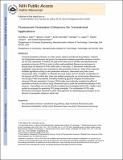Fluorescent penetration enhancers for transdermal applications
Author(s)
Seto, Jennifer E.; Polat, Baris E.; VanVeller, Brett; Langer, Robert; Blankschtein, Daniel; Lopez, Renata F. V.; ... Show more Show less
DownloadBlankschtein_Fluorescent penetration.pdf (2.144Mb)
PUBLISHER_CC
Publisher with Creative Commons License
Creative Commons Attribution
Terms of use
Metadata
Show full item recordAbstract
Chemical penetration enhancers are often used to enhance transdermal drug delivery. However, the fundamental mechanisms that govern the interactions between penetration enhancers and skin are not fully understood. Therefore, the goal of this work was to identify naturally fluorescent penetration enhancers (FPEs) in order to utilize well-established fluorescence techniques to directly study the behavior of FPEs within skin. In this study, 12 fluorescent molecules with amphiphilic characteristics were evaluated as skin penetration enhancers. Eight of the molecules exhibited significant activity as skin penetration enhancers, determined using skin current enhancement ratios. In addition, to illustrate the novel, direct, and non-invasive visualization of the behavior of FPEs within skin, three case studies involving the use of two-photon fluorescence microscopy (TPM) are presented, including visualizing glycerol-mitigated and ultrasound-enhanced FPE skin penetration. Previous TPM studies have indirectly visualized the effect of penetration enhancers on the skin by using a fluorescent dye to probe the transdermal pathways of the enhancer. These effects can now be directly visualized and investigated using FPEs. Finally, future studies are proposed for generating FPE design principles. The combination of FPEs with fluorescence techniques represents a useful novel approach for obtaining physical insights on the behavior of penetration enhancers within the skin.
Date issued
2011-10Department
Massachusetts Institute of Technology. Department of Chemical Engineering; Massachusetts Institute of Technology. Department of ChemistryJournal
Journal of Controlled Release
Publisher
Elsevier
Citation
Seto, Jennifer E., Baris E. Polat, Brett VanVeller, Renata F.V. Lopez, Robert Langer, and Daniel Blankschtein. “Fluorescent Penetration Enhancers for Transdermal Applications.” Journal of Controlled Release 158, no. 1 (February 2012): 85–92.
Version: Author's final manuscript
ISSN
01683659